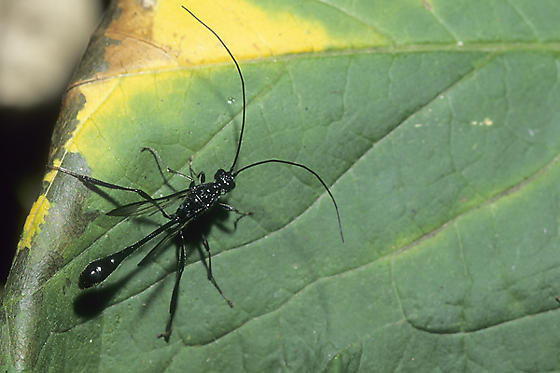Reproduction
Reproduction in P. polyturator is handled primarily through Parthenogenesis (Krombein, et al 1979). Parthenogenesis, when broken down into it's Greek and Latin roots, means "Virgin (partheno-) birth (-genesis)" (Resh and Carde 2003). Parthenogenesis is basically a process where the female can lay eggs that don't require fertilization. Unfertilized eggs turn into females (see diagram). Given this fact, this particular wasp is a very female dominated species. In fact, in the wasps North American range, males are hardly ever found. Males are more common in the wasps southern range, however (Arnett 1985).
Following the above diagram, we see that parthenogenesis primarily produces females. A female will typically produce diploid eggs, which do not require fertilization. These eggs turn into females, which happen to be genetically identical to the parent. However, a sexual cycle does exist, but requires an certain event to facilitate the need to reproduce sexually. For example, the weather may turn unfavorable, the animals habitat may be destroyed, or a required resource may disappear, facilitating the need to mix up the gene pool to increase the chance of species survival. Such an event will cause the female to lay haploid (half the genes) eggs, which hatch into males. These males, in turn, fertilize other haploid eggs, which creates an egg with a full set of genes. This egg will yield a female that is genetically different than it's parents, and thus the cycle continues.

A male Pelecinid wasp. Note the
shorter, fatter build of the creatures abdomen, when
compared to the female wasp (see below).
Not only does P. polyturator reproduce via parthenogenesis, but it also has the oddity of being a parasitic wasp (Arnett 1985). The wasp lays its eggs on a host to let them hatch and pupate. The female uses its ovipositor (a structure typical of all Hymenoptera) to poke around in the ground until the host is found (Eisman and Charney 2010) . The eggs are then stuck to the host, at which point the larvae hatch, burrow into the host, kill it, and use it as a "first meal". The larval wasp then stays in the host to feed, until it is ready to pupate and then become an adult. The May beetle larvae is widely considered to be the wasps host of choice for its young (Bug Guide 2011).
P. polyturator, female.
Note the elongated abdomen, a
distinct characteristic of the female Pelecinid
wasp.
